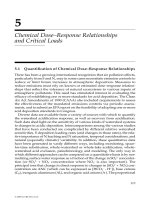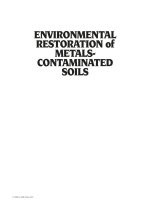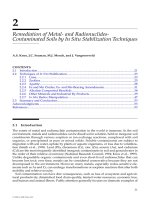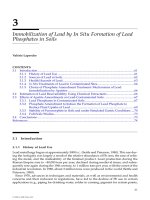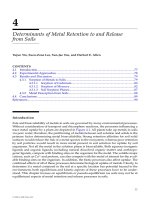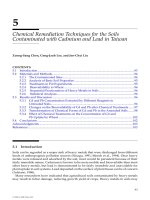ENVIRONMENTAL RESTORATION of METALSCONTAMINATED SOILS - CHAPTER 12 pdf
Bạn đang xem bản rút gọn của tài liệu. Xem và tải ngay bản đầy đủ của tài liệu tại đây (625.29 KB, 17 trang )
243
12
Polyamino Acid Chelation for Metal Remediation
Maury Howard and James A. Holcombe
CONTENTS
12.1 Introduction 243
12.1.1 Role of Chelators in Homogeneous Solution Processes vs. Column Elution 243
12.1.2 Requirements for Successful Use of Immobilized Chelators 244
12.2 Nature’s Metal Binding System: Proteins 245
12.2.1 Using Amino Acids as “Building Blocks” for Chelator Design 245
12.2.2 Metallothioneins 245
12.3 Model System: Poly-L-Cysteine 246
12.3.1 Characteristics of the Cysteine Homopolymer 246
12.3.2 Characterization of Homogeneous PLC 247
12.3.3 Immobilized Poly-L-Cysteine 247
12.3.4 Immobilization Procedure 248
12.3.5 Description of Flow Injection System 249
12.3.6 Characterization of Immobilized PLC 249
12.3.7 Breakthrough Discussion 250
12.3.8 Batch Studies and K
eq
251
12.3.9 Flow Studies and Establishment of K
eq
252
12.3.9.1 pH Effects 254
12.3.10 Redox Characteristics 254
12.4 Conclusions 256
Acknowledgment 257
References 258
12.1 Introduction
12.1.1 Role of Chelators in Homogeneous Solution Processes vs. Column Elution
One common mode of soil remediation involves mobilization of the target metal via leach-
ing or bulk processing of the soils. If the metal is in the correct oxidation state, metal
chelation (e.g., with EDTA) can be used in mobilizing metals from the condensed state (e.g.,
metal oxide) in the soil. When not in the correct oxidation state for chelation, oxidation of
the material often precedes chelation. “Remediation” requires the transfer of the target
material from the contaminated material into another medium, often with the implication
4131/frame/C12 Page 243 Friday, July 21, 2000 4:48 PM
© 2001 by CRC Press LLC
244
Environmental Restoration of Metals–Contaminated Soils
that the contaminant concentration in the medium be greater than in the original site. For
example, a metal chelate can be concentrated via liquid-liquid extraction for purposes of
metal recovery. Alternatively, the solution containing the mobilized metal can be passed
through an appropriate column containing, for example, an ion exchanger to again effec-
tively preconcentrate the target metal. Recovery, in the case of the latter, then involves elu-
tion of the column with the appropriate reagent to strip the metal into a solution of
considerably lower volume than that represented by the original solution.
Both complexation with liquid-liquid extraction and preconcentration using column
methodologies have several prerequisites for optimal employment as a remediation tool:
1. The chelator should be highly selective for the target metal.
2. The complex should have a large formation constant (small
K
d
) when extraction
is taking place.
3. The
K
d
should be “adjustable” to permit easy release of metal if the complexing
reagent or column material is to be reused.
4. Recovery should produce the largest possible ratio of contaminant mass to recov-
ered solution (or solid) mass.
To be cost-effective, the chelating material should be as inexpensive as possible or reus-
able with a lifetime proportional with the initial material cost.
Most ion exchange resins are represented by functionalized polymers. While these mate-
rials often have capacities in the low multiequivalent/gram range, they are often subject to
shrinking and swelling, especially as the pH is changed. This can impact the flow charac-
teristics leading to blockage or flow channeling within the column. An alternative is the use
of a mechanically stable support with a bonded phase. An increasingly common support is
controlled pore glass which has the basic stability and chemical reactivity/inertness of
glass at pH<10, but possesses a very high surface area (ca. 100 m
2
/g in many cases) as a
result of its high porosity. While the material is not prone to shrinking, it is somewhat frag-
ile and the more porous of these materials may not likely stand up to the pressures associ-
ated with, for example, HPLC. These support materials are often available with active
functionalities previously attached or linker arms can be added to the silica surface to
accomplish immobilization (i.e., bonding) of an active complexing agent to the surface.
12.1.2 Requirements For Successful Use of Immobilized Chelators
As is the case with complexation in homogeneous solutions, polydentate ligands offer
advantages over monodentate ligands via the “chelating effect.” With properly spaced
binding functionalities on a single chelating ligand, once an initial alignment of the target
metal and one of the binding functionalities has been established, the rate of attachment of
the second functionality of the same chelator to the target metal is considerably faster than
would be the attachment of a second monodentate ligand. However, it is imperative that
the steriochemistry of immobilized polydentate ligand that provided the chelate effect not
be perturbed as a result of the immobilization. Additionally, the immobilization should not
significantly impact the charge density, stereochemistry, etc. of the complexing functional-
ity if the complexation strength that was exhibited in solution is not to be significantly
altered once the chelator has been immobilized. It is obvious that immobilized monoden-
tate ligands might not yield the same overall formation constant as is observed in homoge-
neous solutions when large coordination numbers (n > 1) were responsible for the
complexation strength. This is a simple result of the geometric constraints imposed by sur-
face immobilization.
4131/frame/C12 Page 244 Friday, July 21, 2000 4:48 PM
© 2001 by CRC Press LLC
Polyamino Acid Chelation for Metal Remediation
245
12.2 Nature’s Metal Binding System: Proteins
12.2.1 Using Amino Acids as “Building Blocks” for Chelator Design
It is well known that proteins have a propensity for metal binding and, in fact, metal incor-
poration is required for many enzymatic systems to be active. While proteins have not been
used directly for metal preconcentration or soil remediation, they are obviously an inherent
part of biological systems (e.g., plants, microbes, etc.) that are actively pursued for remedia-
tion activities. In the areas of metal binding, Crist et al. (1981) were the first to suggest possible
binding moieties based simply on the amino acid functionalities. Two NMR studies further
elaborated on Cd binding to algae and conflictingly report that Cd-S (Majidi et al., 1990) and
Cd-carboxylate (Rayson and Drake, 1996) binding was active.
While a number of proteins incorporate a metal as part of the active center, metallothio-
neins are among the better known class of metal binding proteins (e.g., Stillman et al., 1992;
Sigel and Sigel, 1989; Harrison, 1985). A majority of the studies of metallothioneins have
been directed at the
in situ
metal binding characteristics. However, Anderson (1994) iso-
lated copper metallothionein from yeast cells and immobilized the material on silica. He
reported that
ex situ
behavior of this protein showed minimal preferential selectivity for
copper and comparably strong binding to other metals. Protein binding affinity for several
metals was also reported for intracellular binding (Kagi and Kojima, 1981; Kagi and Vallee,
1961; Li et al., 1980; Hamer, 1986; Winge et al., 1985). Additionally, Anderson’s studies sug-
gest only modest binding strengths once the material was immobilized on silica outside the
cell. This lack of binding strength and selectivity may be due, in part, to the uniqueness of
intracellular chemical environment which has a moderately high ionic strength and is
chemically reducing.
12.2.2 Metallothioneins
Metallothioneins, like other metal-binding proteins, rely on the tertiary structure of the
polypeptide to provide a binding pocket to enhance selectivity based on the size of the
metal ion. The principle is not dissimilar from the design philosophy for “cage molecules”
such as the crown ethers. In these proteins, the tertiary shape is governed by covalent cross-
linking (e.g., disulfide bonds) as well as electrostatics, which includes hydrogen bonding.
As one might expect, the hydrogen bonding of ion-ion and ion-dipole interactions are very
dependent on the local solution environment. While the covalent disulfide bonds are sig-
nificantly stronger, they too can be impacted by the chemical potential of the local solution
environment. It is likely that the combination of these factors contributed to the altered
binding behavior observed by Anderson (1994) once the metallothionein was immobilized
and used outside the cell. It is this altered “activity” that often brands proteins as “fragile”
and has made questionable their utility for tasks (e.g., metal binding) once removed from
the cellular environment. In reality, the fragility might be more correctly assigned to the
tertiary structure of the protein rather than to the intramolecular bonds within the poly-
peptide chain, which are quite robust. It remains, then, to explore the possibility of employ-
ing the varied functionalities associated with amino acids that make up polypeptides as
potential metal-binding chelators while devising a polypeptide design that is less reliant on
the prearranged tertiary structure dictated by the weaker intramolecular forces of H-bonding
and electrostatic interactions that is typical of natural proteins.
4131/frame/C12 Page 245 Friday, July 21, 2000 4:48 PM
© 2001 by CRC Press LLC
246
Environmental Restoration of Metals–Contaminated Soils
12.3 Model System: Poly-L-Cysteine
12.3.1 Characteristics of the Cysteine Homopolymer
The chemical disadvantages inherent to natural proteins are only one practical barrier to
their employment for metal chelation. Additionally, naturally occurring proteins are costly
to purchase or time-consuming in their production or isolation. Figure 12.1 shows a sche-
matic diagram of a Cd-binding metallothionein. As can be seen, cysteine is a primary
metal-coordinating constituent of this and many metallothioneins and is the logical start-
ing place for the investigation of metal complexation by a simple polyamino acid.
There have been studies focusing on the metal binding behavior of cysteine (Elmahadi
and Greenway, 1993; Cherifi et al., 1990; Li and Manning, 1955), but few have pursued com-
pounds containing multiple cysteine or sulfhydryl residues. Poly-L-cysteine (PLC) is such
a system and was first synthesized by Berger et al. (1956) to study the reactivity of the sulf-
hydryl group. PLC is now available commercially (Sigma) as Poly-S-CBZ-L-cysteine, a
homopolymer of cysteines blocked with a carbobenzoxy ring at each sulfhydryl group that
must be removed prior to use. The polymer is prepared by base-initiated polymerization
of its N-carboxyanhydride resulting in a blocked cysteine polymer of M.W. 5,000 to
15,000 Da (approximately 50 cysteine residues long). Berger also noted in his early studies
that PLC is only soluble in alkaline solutions and can be oxidized by hydrogen peroxide,
aerated solutions, and copper (II). Recent studies of PLC in homogeneous solution have
FIGURE 12.1
Metallothionein; cysteines represented by “
—
ⅷ
.” (Stillman, M.J., C.F.S. Shaw, and K.T. Suzuki, VCH Publishers,
New York, 1992, 1.)
METALLOTHONEIN
10
20
30
40
50
60
SER
SER
SER
SER
SER
SER
SER
SER
ARC
LY S
LY S
LY S
LY S LY S
LY S LY S
β
Domain
Domain
α
41
44
37
60
57
50
59
33
48
34
36
1
6
5
7
7
Cd
Cd
Cd
Cd
Cd
Cd
Cd
S
S
SS
S
S
S
S
S
S
S
S
S
S
S
S
S
S
S
Cluster A
Cluster B
3
2
4
13
26
19
15
29
24
5
4131/frame/C12 Page 246 Friday, July 21, 2000 4:48 PM
© 2001 by CRC Press LLC
Polyamino Acid Chelation for Metal Remediation
247
confirmed the importance of pH on the polymer dissolution (Jurbergs and Holcombe, 1997)
and its sensitivity to oxidizing and reducing agents (Howard et al., 1998).
12.3.2 Characterization of Homogeneous PLC
The pK
a
of PLC is ca. 6 (Howard et al., 1999), which is about two pH units lower than that
of the sulfhydryl functionality of cysteine (pK
a
= 8.36) (Edsall and Wyman, 1958). Peptide
bonding can have a large impact on the pKa of the amino acid functional group, causing it
to become more acidic (Edsall and Wyman, 1958), and the proximity of charged groups can
also cause the pH to shift due to electrostatic interferences (Sela et al., 1962; Voet and Voet,
1990). For the cysteine homopolymer where the thiol is the only potential charged group
within the chain (excluding the amine and carboxylic terminals), the material has only lim-
ited solubility in solutions when the pH< pK
a
. Unfortunately, this limits the homogeneous
solution use of PLC to applications where the pH is greater than ca. 5 to 6. At lower pH
values, the material precipitates and is slow to solubilize even after the pH is elevated. It is
likely that when the pH is reduced below the pKa, the previous ion-dipole interactions
which maintained PLC’s solubility disappear as the sulfides become protonated. Denatur-
ation and likely formation of a tight random coil result in the precipitation of the PLC.
Circumvention of this problem through immobilization of the PLC on a solid support will
be discussed in a later section.
The “soft base” character of the thiol group predicts a preference for “soft-acid” metal
binding, which suggests that PLC will be inherently selective in binding/complexing met-
als such as Hg, Cd, and Pb. Torchinskii and Moiseevich (1974) state that the sulfide group
binds univalent cations: Hg
+
, Ag
+
, Cu
+
, Au
+
; divalent cations: Hg
2+
, Pb
2+
, Cu
2+
, Cd
2+
, Zn
2+
;
and even tervalent ions: As
3+
and Sb
3+
. As seen by Li and Manning (1955), the binding
affinity of thiol compounds glutathione and 2-mercaptoethylamine seems to follow the
order Pb
2+
>Cd
2+
>Zn
2+
. Homogeneous solution titrations of the PLC with these metals
appear to support this natural selectivity (Autry and Holcombe, 1995). In these titrations
4(2-pyridylazo) resorcinol (PAR) was chosen as the metal-binding indicator (Shibata, 1972).
The absorbance maxima for the PAR complex with Zn, Cd, and Cu appear at 490, 494, and
498 nm, respectively. Figure 12.2 shows the spectrophotometric titration results where the
absorbance has been converted to metal-PAR concentrations for the ordinate.
Since PAR represents a competing ligand for PLC complexation of the metal, these titra-
tions confirmed the relative strength of some of the sites for the metal-PLC complex and
showed that multiple binding sites exist on each of the PLC polymer chains as shown in
Table 12.1. Not unexpectedly, the presence of excess Na
+
(0.016
M
) or Ca
2+
(5.0
×
10
–4
M
)
resulted in no displacement, for example, of Zn
2+
from the Zn-PLC complex, indicating a
strong preference for Zn
2+
. In fact, this is consistent with the results from cysteine immobi-
lized on silica, which also showed little affinity for alkali and alkaline earth metals
(Elmahadi and Greenway, 1993). These two studies clearly indicate the potential selectivity
inherent to the thiol functionality associated with cysteine and the polymer PLC. This
binding preference may be exploited for metal-specific extraction, preconcentration and
remediation, even in the presence of high salt matrices.
12.3.3 Immobilized Poly-L-Cysteine
As noted previously, the limited solubility (especially at pH < 6) of PLC gives the material
limited utility for metal chelation in homogeneous solution applications. However, by
immobilizing PLC on a support (e.g., porous glass), many of these problems disappear
and, in fact, may serve to enhance some performance capabilities as will be shown in sub-
sequent sections.
4131/frame/C12 Page 247 Friday, July 21, 2000 4:48 PM
© 2001 by CRC Press LLC
248
Environmental Restoration of Metals–Contaminated Soils
12.3.4 Immobilization Procedure
Showing a potential for metal extraction and separation, PLC was immobilized to study its
effectiveness in “on-line” column applications. Proteins are immobilized routinely on vari-
ous types of substrates including agarose and polyacrylamide gels, cross-linked polymer
beads, and silica. Controlled pore glass (CPG) was selected as the support for PLC due to its
stability and high surface area. CPG is rugged enough to stand up to high flow rates and
back pressures that occur in flow injection systems, viz., low pressure chromatography. The
glass is also resistant to pH effects and does not shrink or swell when the pH is drastically
altered. Finally, CPG boasts a surface area of ca. 94 m
2
/g due to its high porosity. The immo-
bilization of PLC on CPG closely follows a procedure described by Masoom and Townshend
(1984) for the immobilization of enzymes on CPG. However, prior to its immobilization, the
PLC must be deblocked by removing the carbobenzoxy ring using a sodium ammonia
FIGURE 12.2
Spectrophotometric titration of PLC with Zn(
◆
), Cd (m), Cu (
∇
) using the metal-PAR colored complexes to
calculate the concentration of PLC’s strong binding sites for Zn, Cd, and Cu.
TABLE 12.1
Metal Capacity for PLC
Metal PLC (mmol/g) PLC (sites/mol)
Zn
2+
0.40 2.1
Cd
2+
1.4 7.4
Cu
2+
0.14 0.76
6.0
5.0
4.0
3.0
2.0
1.0
0.0
-1.0
0.0 10
20
30
40
50
60
70
80
Formal Metal Concentration (x 10
6
mol/L)
Concentration of Metal(PAR)
n
(x 10
6
mol/L)
4131/frame/C12 Page 248 Wednesday, August 9, 2000 5:28 PM
© 2001 by CRC Press LLC
Polyamino Acid Chelation for Metal Remediation
249
reduction reaction (Berger et al., 1956), which was executed with dithiothreitol (DTT)
(Cleland, 1964) present during reaction as a protecting agent to prevent oxidation of cys-
teine’s sulfhydryl residues.
In brief, CPG is prepared for immobilization by activating the glass using dilute HNO
3
and heating. The activated glass is silanized via reaction with an aminoalkylating agent,
3-aminopro-pyltriethoxysilane. Gluteraldehyde, a bifunctional reagent, links the amine
terminus of the PLC to the amine terminus of the surface silane group completing the
immobilization of PLC on CPG as shown in Figure 12.3.
The efficiency of this reaction has been measured as a function of the surface coverage of
PLC on the glass surface. An acid titration of the sulfides of the immobilized PLC was run
to estimate the surface coverage, assuming 50 residues/polypeptide, and yielded an esti-
mate of ca. 1 to 5% surface coverage with ca. 6.8
×
10
–6
moles PLC/g PLC-CPG (Jurbergs
and Holcombe, 1997). This number was supported by a sulfur analysis using ICP which
showed a concentration of 5.3
×
10
–6
moles PLC/g PLC-CPG.
12.3.5 Description of Flow Injection System
Some of the reasons for use of a flow injection analysis (FIA) system are its low sample/
reagent consumption and high sample throughput (Fang, 1993) These advantages are fur-
ther augmented when the system is used with a preconcentration column for analysis. In
this case, the detectibility can be significantly improved through analyte preconcentration
on the column and interferences reduced via analyte separation from the matrix (Burguera,
1989). FIA can be used to evaluate separation processes that might be used in a larger scale
operation and is easily automated to enhance sample throughput. FIA is also easily inter-
faced with detection systems like a flame atomic absorption spectrometer (FAAS), which
makes it very useful for metal separation and preconcentration studies.
Figure 12.4 is a diagram of a typical FIA system in which samples and reagents are
selected through a valve system and delivered to a microcolumn by a peristaltic pump.
Finally, the effluent is introduced to the FAAS where air compensation is provided by a
T-junction prior to the nebulizer to make up for the difference between the nebulizer
uptake rate and the peristaltic pump rate. Table 12.2 outlines a typical protocol for the use
of the system shown in Figure 12.4.
12.3.6 Characterization of Immobilized PLC
Once PLC was immobilized on CPG, it became a more versatile material with which to
work. For instance, under acidic conditions PLC undoubtedly still undergoes drastic con-
formation change (e.g., formation of a tight random coil); however, it can no longer agglom-
erate since it is bonded to the glass. Alteration to its more open form with an increase in
solution pH occurs reversibly and rapidly (Jurbergs and Holcombe, 1997). Additionally, it
can be oxidized and reduced reversibly by passing suitable agents through the column
FIGURE 12.3
Attachment of PLC to controlled pore glass (CPG) through gluteraldehyde bifunctional linker.
CPG
O
OEt
Si
OEt
(CH
2
)
3
N
CH
(CH
2
)
3
CHO
H
HN
CH CO
CH
2
SH
n
OH
4131/frame/C12 Page 249 Wednesday, August 9, 2000 5:28 PM
© 2001 by CRC Press LLC
250
Environmental Restoration of Metals–Contaminated Soils
(Howard et al., 1998). PLC is also very strongly attached to the surface of the glass and,
unlike most natural proteins, it is extremely rugged and can withstand extended exposure
to acids (e.g., 1
M
HNO
3
) and repeated exposure to hydrogen peroxide without any notice-
able change in its binding characteristics once it is returned to its optimal binding mode of
being fully reduced and in a solution whose pH is greater than 6.
12.3.7 Breakthrough Discussion
“Breakthrough curves” and “strips” are commonly used for column characterization and
data analysis for “on-line” systems. A complete breakthrough curve represents the change
in the amount of metal in the column effluent as the amount introduced to the column
is increased until, finally, the column reaches equilibrium capacity for that particular
influent concentration.
Figure 12.5a is a typical breakthrough curve shape for Cd introduced into a PLC-CPG
microcolumn. A metal solution is passed through the column and the metal in the effluent
is recorded as a function of volume passed through the column. The presence of a baseline
signal is indicative of quantitative binding (i.e., nearly 100% of the metal introduced to the
column is bound) and suggests chelation to strong sites. The saturation of these binding sites
results in “breakthrough,” indicated by an increase in effluent concentration above the
baseline level. The sloped region reveals weaker binding where only a fraction of the metal
introduced is bound to the column. When the effluent concentration is equal to the influent
concentration, the column has reached equilibrium capacity and the total amount of metal
bound can be calculated from the shaded area in Figure 12.5a. The data collected from this type
of experiment can be converted to binding isotherms in a relatively straightforward manner:
FIGURE 12.4
Typical flow injection system. R
1-6
, reagents or sample as selected by 6-position Teflon rotary valve; P, peristaltic
pump; V
1,2
, 3-way slider valves; C, microcolumn (e.g., Omnifit 25 mm
×
3 mm i.d.); D, detector (e.g., flame AA).
TABLE 12.2
Typical Protocol for FIA System
Operation
Solution
Input
Valve 1
Position
Valve 2
Position Notes
Column conditioning Buffer b b
Breakthrough curve Sample b b FAA data collection
Strip (line fill) Acid a a
Strip Acid b ** **Sample sent to
D
(e.g., FAA) if
preconcentration mode used;
otherwise, sent to waste or fixed
volume container for analysis
Calibration curve Acidified stds b b FAA readings taken
Column prep Acid b b
R
1
R
2
R
3
R
4
R
5
R
6
P
(b)
(a)
V
1
C
Waste
Waste
Waste
(b)
(a)
V
2
D
4131/frame/C12 Page 250 Wednesday, August 9, 2000 5:28 PM
© 2001 by CRC Press LLC
Polyamino Acid Chelation for Metal Remediation
251
(1)
where
C
s
is the metal bound to the stationary phase after a volume V is passed through the
column,
C
o
is the influent concentration, and
C
m
is the mobile phase effluent concentration.
A plot of
C
s
vs.
C
m
yields the binding isotherm.
The metal can also be stripped from the column with a suitable eluent (e.g., dilute acid
works well for PLC), resulting in a stripping peak similar to that indicated in Figure 12.5b.
Again, the shaded area in Figure 12.5b represents the amount stripped and, in the case of
quantitative recovery, should be the same area as the shaded region in Figure 12.5a.
12.3.8 Batch Studies and K
eq
Slow mass transport between the phases in column or slow kinetics can fail to establish
equilibrium (Fang, 1993). For accurate determinations of the equilibrium constants for
metal-PLC complexes, batch mode studies need to be conducted. To accurately determine
the formation constants or, conversely, the dissociation constants of the strong binding
sites, competing ligands are used in the bulk solution. For the strongest Cd binding sites on
PLC, ethylenediamine tetraacetic acid (EDTA) was employed as the competing ligand.
Ethylenediamine (en) was used as a competing ligand for somewhat weaker sites. The
equilibrium between Cd and either PLC or the competing ligand,
L
, is given by:
PLC
+
CdL
n
=====
Cd – PLC
+
nL
(2)
where the following two equilibria must also hold:
PLC
+
Cd
2+
=====
Cd – PLC K
f = [
Cd
–
PLC
]/[
Cd
2+
][
PLC
] (3)
CdL
n
=====
Cd
2
+
nL K
d
= [
Cd – L
n
]/[
Cd
2+
][
L
]
n
(4)
FIGURE 12.5
Typical breakthrough curve (a) and strip peak (b).
C
s
C°VC
m
Vd
0
V
∫
–=
K
eq
Cd PLC–[]L[]
n
Cd
n
[]PLC[]
K
f
K
d
==
4131/frame/C12 Page 251 Friday, July 21, 2000 4:48 PM
© 2001 by CRC Press LLC
252 Environmental Restoration of Metals–Contaminated Soils
The formal amounts of metal and ligand in the system are known; the total Cd in the solu-
tion C
sol
can be determined and the Cd bound to the immobilized PLC can be calculated
([Cd – PLC] = C
0
Cd
– C
sol
) after appropriate correction for dimensions used. Assuming fur-
ther that C
0
L
≥ n C
0
Cd
, then the following approximation is reasonable:
C
sol
= [Cd
2+
] + [CdL
n
] ≈ [CdL
n
] (5)
This permits restatement of K
f
:
(6)
Since both K
f
and C
0
PLC
are unknown, at least two measurements must be made at different
concentrations. However, the use of competing equilibria using a complexing agent with a
known K
d
circumvents the problem of working with extremely low metal concentrations and
attempting to measure extremely small quantities of free metal in the equilibrated solution.
These binding strength studies carried out by Jurbergs and Holcombe (1997) resulted in
the determination of four types of binding sites for immobilized PLC. The first site was
stronger than Cd-EDTA and its binding constant estimated to be K
1
> 10
13
; and the next was
10
9
< K
2
< 10
11
, being stronger than en, but weaker than EDTA. The weak sites were esti-
mated using a non-linear least squares algorithm (Cernick and Borkovec, 1995). The forma-
tion constants for the remaining weaker sites ranged from 10
7
to 10
4
.
12.3.9 Flow Studies and Establishment of K
eq
Cd chelation properties of immobilized PLC were investigated using the flow system
described in Figure 12.4 for extraction of Cd from buffered aqueous solutions. The impacts
of influent concentration and flow rate on the column were characterized. From the break-
through curves in Figure 12.6 where different flow rates are studied, it is clear that equilib-
rium is not established within the column at these flow rates. Effective stability constants
were calculated for the moderate and weak sites and a number of strong sites were reported
for the flow systems (Jurbergs and Holcombe, 1997). The metal influent concentration has
an influence on the measured capacity of the column, as one would expect when weaker
sites are present that do not become fully occupied.
As noted previously, the breakthrough curve data can be easily converted to isotherms.
These data were analyzed for the flow system using the Levenberg-Marquardt algorithm
to obtain binding strengths and capacities. The results were comparable to the true equilib-
rium values obtained from the batch experiments, especially for the lower flow rate of
0.55 mL/min (Jurbergs and Holcombe, 1997).
Immobilized PLC’s metal extraction performance was compared with 8-hydroxyquino-
line (8HQ) (Howard et al., 1999), a material well characterized in metal extraction and pre-
concentration applications (Chow and Cantwell, 1988; Malamas et al., 1984; Marshall and
Mottola, 1983). The ability to effectively extract metals from seawater matrices is a property
of 8HQ, which has been thoroughly studied (e.g., Willie et al., 1983; Sturgeon, 1981; Seubert,
1995; Fang et al., 1984). The studies showed that both resins (1) perform well for Cd precon-
centration and recovery in a seawater matrix, (2) exhibited flow rate dependent extraction
efficiency, and (3) exhibited more than one type of binding site. However, the enhanced
selectivity of PLC for the soft acid metals permitted distinction from 8HQ for the quantita-
tive extraction of Cd in the presence of a Co and Ni matrix, as shown in Table 12.3.
K
f
KC
0
Cd
C
sol
–()C
0
L
C
sol
–()
n
C
sol
C
0
PLC
C
0
Cd
– C
sol
+()
=
4131/frame/C12 Page 252 Friday, July 21, 2000 4:48 PM
© 2001 by CRC Press LLC
Polyamino Acid Chelation for Metal Remediation 253
In the microcolumn, on-line FIA system, it was suspected that mass transport prohibited
the establishment of equilibrium within the column at the flow rates employed (Fang, 1993).
This was confirmed by comparing the effective reduction in the strong site capacities for
PLC and 8HQ as the flow rate increased, i.e., as the solution contact time with the immobi-
lized chelator decreased. Figure 12.7 shows this comparison. It should be pointed out that
the two immobilized chelators are physically different from each other (i.e., PLC is a poly-
meric chain with a large number of potential binding sites, while 8HQ is a simpler bifunc-
tional ligand) and their binding sites do not resemble each other chemically. Thus, it is
unlikely that binding kinetics are sufficiently similar to promote the similarity in flow rate
dependence observed (Fang, 1993).
Effective stability constants of Cd-PLC and Cd-8HQ obtained in the FIA system were
determined using nonlinear least squares analysis of the Cd binding data and are shown in
Table 12.4.
Although 8HQ has a larger number of strong binding sites than PLC, this does not nec-
essarily make it a better choice for remediation, as can be seen in the Co and Ni matrix stud-
ies that illustrate the importance of selectivity.
FIGURE 12.6
Breakthrough curves for Cd on PLC at pH 7.
TABLE 12.3
Cd Recovery Efficiencies for PLC and 8HQ (5 min loading at pH 7)
100 ppb Cd in Seawater 50 ppb Cd (1.00 mL/min)
1.00 mL/min 5.00 mL/min 500 ppm Co 500 ppm Ni
PLC 108 ± 8% 103 ± 6% 101 ± 3% 102 ± 3%
8HQ 94 ± 8% 101 ± 6% 2 ± 1% 4 ± 1%
4131/frame/C12 Page 253 Friday, July 21, 2000 4:48 PM
© 2001 by CRC Press LLC
254 Environmental Restoration of Metals–Contaminated Soils
12.3.9.1 pH Effects
The effect of pH on capacity (Table 12.5) shows that PLC has a greater capacity for Cd in
more alkaline solutions. This is due to the greater number of deprotonated SH groups at
pHs greater than 6, the pK
a
of immobilized PLC, since the more reactive form of the
sulfhydryl group is the deprotonated form, the mercaptide ion (S
–
) (Torchinskii and
Moiseevich, 1994).
12.3.10 Redox Characteristics
Studies of immobilized PLC revealed interesting and potentially useful redox properties.
Berger et al. (1956) showed that SH groups of PLC can be oxidized to disulfides or sulfenites
by oxygen or hydrogen peroxide as well as oxidizing metals such as Cu(II) (Berger et al.,
1956). Although, in homogeneous solution the oxidation of PLC results in a cross-linked,
insoluble product (Berger et al., 1956), the oxidation of immobilized PLC has been shown
to be fully reversible by reduction of the column with dithiothreitol (DTT) (Howard et al.,
1998), and the original binding properties of the column restored. DTT and PLC have a sim-
ilar pH dependence due to their common reactive thiol groups, and this dependence can
be employed to produce intermediate stages of reduction which provide different levels of
capacity and binding strength of the PLC (Howard et al., 1998). As shown in Figure 12.8,
the capacity of the column can be controlled by oxidizing the column with peroxide and
reducing with DTT at pH 4.5 for varied times. Full reduction at this pH takes up to 48 h,
but at pH 8.1 the reduction is complete within 10 min.
FIGURE 12.7
Flow rate dependence of strong site capacity for PLC and 8HQ.
4131/frame/C12 Page 254 Friday, July 21, 2000 4:48 PM
© 2001 by CRC Press LLC
Polyamino Acid Chelation for Metal Remediation 255
TABLE 12.4
Conditional Stability Constants and Number of Sites for
Cd-8HQ and Cd-PLC Complexes, pH 7.0
8-Hydroxyquinoline-CPG Poly-L-Cysteine-CPG
K
1
= 10
9
– 10
11
K
1
= 1 ± 0.5 × 10
13
K
2
= 4 ± 1 × 10
8
K
2
= 10
9
– 10
11
K
3
= 2 ± 1 × 10
6
K
3
= 1 ± 1 × 10
6
K
4
= 2 ± 0.5 × 10
4
K
4
= 2 ± 1 × 104
n
i
(mmol/g 8HQ-CPG) n
i
(mmol/g PLC-CPG)
n
1
= 10 n
1
= 1 ± 0.1
n
2
= 12 ± 0.1 n
2
= 6
n
3
= 3 ± 1 n
3
= 20 ± 1
n
4
= 33 ± 1 n
4
= 10 ± 3
TABLE 12.5
Effective Cd Capacities for Reduced PLC-CPG with
Influent Flow Rate of 1.00 mL/min
pH Cd Bound (mmol/g of CPG) Cd recovered (%)
4 3 ± 1 111 ± 12
5 15 ± 2 65 ± 2
6 11 ± 1 105 ± 6
7 16 ± 1 110 ± 6
8 22 ± 2 91 ± 6
9 42 ± 3 90 ± 1
FIGURE 12.8
Cd breakthroughs run at several levels of reduction from the peroxide oxidized state.
4131/frame/C12 Page 255 Friday, July 21, 2000 4:48 PM
© 2001 by CRC Press LLC
256 Environmental Restoration of Metals–Contaminated Soils
Different oxidizing agents were also studied for their effects on immobilized PLC: hydro-
gen peroxide, oxygen, and Cu
2+
. Studies showed the peroxide to be the most efficient oxi-
dant, resulting in full oxidation within minutes, whereas oxygen was much slower to
oxidize the PLC. Oxygen oxidation is suspected of being rate limited by the slow kinetics
of O
2
bond dissociation (38), but has proven to be much faster in the presence of oxidizing
metals like Fe
3+
or Cu
2+
(23).
Even in its oxidized form, PLC retains many of its strongest binding sites and can be
effectively used for preconcentration of trace quantities as is shown in the following tables
(Tables 12.6 and 12.7). In Table 12.8 it can be seen that although capacity is diminished by
oxidation, the binding remains selective and strong enough to be very effective for precon-
centration applications.
12.4 Conclusions
Any remediation activity or preconcentration is optimally served by a highly selective che-
lator, since it is uncommon that the objective is to isolate all metals in the sample. Addition-
ally, the selectivity inherently provides the chelator with enhanced performance in complex
TABLE 12.6
Effective Cd Capacities for Oxidized States of PLC-CPG (pH 7.0, 1.0 mL/min)
Fully
Reduced
Partially
Reduced
10 min H
2
O
2
Oxidation
18 h Oxygen
Oxidation
a
18 h Oxygen
Oxidation
b
Total capacity (µmol/g) 4.8 ± 0.2 4.1 ± 0.2 2.2 ± 0.1 3.1 3.2
Strong site capacity 2.5 ± 0.3 1.2 ± 0.1 < 0.2 0.74 1.3
a
Oxidation from partially reduced state.
b
Oxidation from fully reduced state.
TABLE 12.7
Cd, Zn, and Pb Effective Capacities and Recoveries for Peroxide-Oxidized
PLC-CPG (pH 7.0, 1.0 mL/min)
Metal Strong Sites (µmol/g CPG) Total Sites (µmol/g CPG) Recovery
Cd < 0.2 2.2 ± 0.1 100 ± 4
Zn < 0.1 11 103 ± 2
Pb 2.5 5.0 105 ± 5
TABLE 12.8
Preconcentration of 26 ppb Cd from Na, K, Mg, Ca, and
Cu(II) Matrices Using H
2
O
2
Oxidized PLC-CPG (pH 7.0,
3 mL samples at a flow of 1.0 mL/min)
Matrix Metal Cd Recovery (%)
Na (500 ppm) 93 ± 3
K (500 ppm) 92 ± 3
Mg (500 ppm) 93 ± 4
Ca (500 ppm) 91 ± 2
Cu (10 ppm) 100 ± 3
4131/frame/C12 Page 256 Friday, July 21, 2000 4:48 PM
© 2001 by CRC Press LLC
Polyamino Acid Chelation for Metal Remediation 257
matrices since competition between the target metal and interfering ions is minimized.
Optimal use of chelators for metal extraction further dictates the ability to easily release the
target metal for purposes of recovery and ultimate disposal or reuse of the material in a
compact, concentrated form.
The potential of immobilized polyamino acids, as illustrated by the initial work with
poly-L-cysteine, for such remediation and preconcentration activity has been demon-
strated. The chain apparently reaches a free energy minimum for complexation through
tertiary structure alteration during binding. This is likely responsible for the strong binding
as well as the easy release when this tertiary structure is perturbed, e.g., alteration in pH to
convert bonding mode of PLC to a tight random coil with little binding strength or capacity.
This provides the stereochemistry afforded by natural proteins and cage-type molecules
while affording the opportunity for easy, reversible metal release and ruggedness.
The tertiary structure of PLC responsible for the strong binding is similar to the motif
used in nature, although the relative size of the PLC compared to many natural proteins
and the absence of a fixed tertiary structure in the absence of the metal does not render the
polyamino acids inactive after harsh acid treatment, as is the case for nature’s proteins. By
immobilizing the polymers, reversible chemistry (e.g., protonation/deprotonation and
oxidation/reduction) can be performed without degradation of the activity or loss of
binding capacity. Columns subjected to numerous cycles of acid stripping and harsh
oxidation over a period of years have retained their binding capacity and strength, thus
satisfying the prerequisite for an effective ion exchanger intended for practical remedia-
tion, i.e., an extended lifetime.
This preliminary work with PLC illustrates the potential for a new mode of complexation
through the use of polyamino acid polymers and copolymers. Since all are polypeptides,
the chemistry required for their production is identical, thus eliminating the need for elab-
orate synthetic projects to construct and test new polymers. The amino acid “building set”
also provides an array of cation, as well as anion, ligand functionalities from which to con-
struct the chelator. Strong binding is not “forced” through the geometry built into the sys-
tem as is the case with fixed cage-type molecules or traditional polydentate ligands.
Instead, the long, coiled nature of the polymer and reliance on thermodynamic driving
forces to minimize the system’s free energy foster coiling around the target metal to achieve
optimal stereochemistry for strong complexation.
In particular, PLC has proven to be an efficient chelator for “soft acid” metals such as Cd,
Pb, and Zn, and its inherent selectivity enhances its performance in high salt and even some
transition metal matrices, which makes PLC a competitive metal extraction tool even when
compared to well-characterized and widely used 8HQ. Immobilization on a robust station-
ary support has enhanced its useful lifetime, although the half-life has not yet been deter-
mined since the longest operating column continues to perform as per its initial
specifications for 3 years. However, like other chelators it is of limited utility for the rapid
extraction of metals from complexes (e.g., metal-EDTA) where dissociation kinetics of the
solution complex are rate limiting.
Acknowledgment
This work was supported, in part, by a grant from the Gulf Coast Hazardous Substance
Research Center, Beaumont, Texas.
4131/frame/C12 Page 257 Friday, July 21, 2000 4:48 PM
© 2001 by CRC Press LLC
258 Environmental Restoration of Metals–Contaminated Soils
References
Anderson, B., Evaluation of Immobilized Metallothionein for Trace Metal Separation and Precon-
centration, Ph.D. thesis, University of Texas, Austin, 1994.
Autry, H.A. and J.A. Holcombe, Cadmium, copper and zinc complexes of poly-L-cysteine, Analyst,
120, 2643, 1995.
Bard, A.J., Chemical Equilibrium, Harper and Row, New York, 1966.
Berger, A., J. Noguchi, and E. Katchalski, Poly-L-cysteine, J. Am. Chem. Soc., 77, 4483, 1956.
Burguera, J.L., Flow injection atomic spectroscopy, in Practical Spectroscopy, Vol. 7, E.G. Brame, Jr.,
Ed., Marcel Dekker, New York, 1989, 1.
Cernik, M. and M. Borkovec, Regularized least-squares methods for the calculation of discrete and
continuous affinity distribution for heterogeneous sorbents, Environ. Sci. Technol., 29, 413, 1995.
Cherifi, K., B.D L. Reverend, K. Varnagy, T. Kiss, I. Sovago, C. Loucheux, and H. Kozlowski,
Transition metal complexes of L-cysteine containing di- and tripeptides, J. Inorg. Biochem., 38,
69, 1990.
Chow, P.Y.T. and F.F. Cantwell, Calcium sorption by immobilized oxine and its use in determining
free calcium ion concentration in aqueous solution, Anal. Chem., 60, 1569, 1988.
Cleland, W.W., Dithiothreitol, a new protective reagent for SH groups, Biochemistry, 3, 480, 1964.
Crist, R.H., K. Oberholser, N. Shank, and M. Nguyen, Nature of bonding between metallic ions and
algal cell walls, Environ. Sci. Technol., 15, 1212, 1981.
Edsall, J. and J. Wyman, Biophysical Chemistry, Vol. 1, Academic Press, New York, 1958.
Elmahadi, H.A.M. and G.M. Greenway, Immobilized cysteine as a reagent for preconcentration of
trace metals prior to determination by atomic absorption spectrometry, J. Anal. At. Spectrom., 8,
1011, 1993.
Fang, Z L., Flow Injection Separation and Preconcentration, VCH Publishers, New York, 1993.
Fang, Z L., J. Ruzicka, and E.H. Hansen, An efficient flow-injection system with on-line ion-exchange
preconcentration for the determination of trace amounts of heavy metals by atomic absorption
spectrometry, Anal. Chim. Acta, 164, 23, 1984.
Hamer, D.H., Metallothionein, Ann. Rev. Biochem., 55, 913, 1986.
Harrison, P.M., Metalloproteins, Verlag Chemie, Weinheim, 1985.
Howard, M., H. Jurbergs, and J.A. Holcombe, Effects of oxidation of immobilized poly-L-cysteine
on trace metal chelation and preconcentration, Anal. Chem., 70, 160, 1998.
Howard, M.E., H.A. Jurbergs, and J.A. Holcombe, Comparison of 8-hydroxy quinoline and poly-L-
cysteine for trace metal preconcentration, J. Anal. At. Spectrom., 14, 1209, 1999.
Jurbergs, H.A. and J.A. Holcombe, Characterization of immobilized poly(L-cysteine) for cadmium
chelation and preconcentration, Anal. Chem., 69, 1893, 1997.
Kagi, J.H.R. and B.L. Vallee, Metallothionein: a cadmium and zinc-containing protein from equine
renal cortex, J. Biol. Chem., 236, 2435, 1961.
Kagi, J.H.R. and Y. Kojima, Chemistry and biochemistry of metallothionein, in Metallothionein II,
Vol. 52, Kagi, J.H.R. and Kojima, Y., Eds., Birkhauser Verlag, Basel, 1987, 25.
Li, N.C. and R.A. Manning, Some metal complexes of sulfur-containing amino acids, J. Am. Chem.
Soc., 77, 5225, 1955.
Li, T.–Y., A.J. Kraker, C.F. Shaw, and D.H. Petering, Ligand substitution reactions of metallothioneins
with EDTA and apo-carbonic anhydrase, Proc. Natl. Acad. Sci., 77, 6334, 1980.
Majidi, V., J.D.A. Laude, and J.A. Holcombe, Investigation of metal-algae bonding nature by 113Cd
nuclear magnetic resonance, Environ. Sci. Technol., 24, 1309, 1990.
Malamas, J., M. Bengtsson, and G. Johansson, On-line trace metal enrichment and matrix isolation
in atomic absorption spetrometry by a column containing immobilized 8-quinolinol in a flow-
injection system, Anal. Chim. Acta, 160, 1, 1984.
Marshall, M.A. and H.A. Mottola, Synthesis of silica-immobilized 8-quinolinol with (aminophenyl)-
trimethoxysilane, Anal. Chem., 55, 2089, 1983.
4131/frame/C12 Page 258 Friday, July 21, 2000 4:48 PM
© 2001 by CRC Press LLC
Polyamino Acid Chelation for Metal Remediation 259
Masoom, M. and A. Townshend, Determination of glucose in blood by flow injection analysis and
an immobilized glucose oxidase column, Anal. Chim. Acta, 166, 111, 1984.
Rayson, G. and L. Drake, Plant-derived materials for metal ion-selective binding and preconcentration,
Anal. Chem., 68, 22A, 1996.
Sela, M., S. Fuchs, and R. Arnon, Studies on the chemical basis of the antigenicity of proteins, Biochem. J.,
85, 223, 1962.
Seubert, A., G. Petzold, and J.W. McLaren, Synthesis and application of an inert type of 8-hydroxy-
quinoline-based chelating ion exchanger for seawater analysis using on-line inductively coupled
plasma mass spectrometry detection, J. Anal. At. Spectrom., 10, 371, 1995.
Shibata, Chelates in Analytical Chemistry, Vol. 4, Marcel Dekker, New York, 1972.
Sigel, H. and A. Sigel, Metal Ions in Biological Systems, Marcel Dekker, New York, 1989.
Stillman, M.J., C.F.S. Shaw, and K.T. Suzuki, Metallothioneins: Synthesis Structure and Properties of
Metallothioneins, Phytochelatins and Metal-Thiolate Complexes, VCH Publishers, New York, 1992, 1.
Sturgeon, R.E., S.S Berman, S.N. Willie, and J.A.H. Desauiniers, Preconcentration of trace elements
from seawater with silica-immobilized 8-hydroxyquinoline, Anal. Chem., 53, 2337, 1981.
Torchinskii, Y.M. and I. Moiseevich, Sulfhydryl and Disulfide Groups of Proteins, Consultants Bureau,
New York, 1974.
Voet, D. and J.G. Voet, Biochemistry, Wiley, New York, 1990.
Willie, S.N., R.E. Sturgeon, and S.S. Berman, Comparison of 8-quinolinol-bonded polymer supports
for the preconcentration of trace metals from sea water, Anal. Chim. Acta, 149, 59, 1983.
Winge, D.R., K.B. Nielson, N.R. Gray, and D.H. Hamer, Yeast metallothionein. Sequence and metal-
binding properties, J. Biol. Chem., 260, 14464, 1985.
4131/frame/C12 Page 259 Friday, July 21, 2000 4:48 PM
© 2001 by CRC Press LLC

